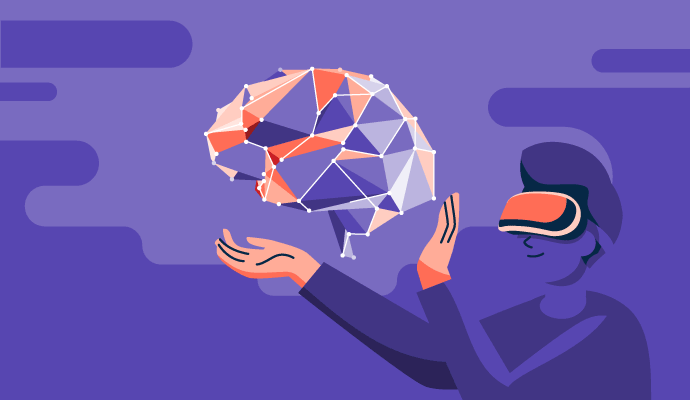What is augmented reality?
Augmented reality (AR) is a technology that digitally replicates real-world elements like sound and video. Visual and auditory sensory experiences are often overlaid in the environment to enhance the user’s perception of their real-world settings.
AR doesn’t create an entire world in the digital space as virtual reality (VR) does. Instead, AR adds details to what already exists in physical reality. Even with only limited interaction potential between humans and technology, the addition of AR changes how the user feels. Holograms are a good example of AR enhancing events like museum visits or live entertainment.
With the development of 3D and 4D technologies, businesses use AR visualization software to engage with consumers in a new way. For customers, trying on glasses virtually or seeing a piece of furniture in their own space clarifies purchase decisions.
Types of augmented reality
Many different applications of augmented reality are being created and refined, but the technology can be separated into two distinct types:
- Marker-based AR. This uses object recognition and target images, or markers, to position objects within a real space via a smartphone or other device. The camera continuously scans the real environment, looking for appropriate ways to place the mapped object into view. Tools like Instagram and TikTok filters use two-dimensional markers to add visual stimuli into the user’s real world.
- Markerless AR. In contrast, markerless AR places virtual objects into the environment by looking at the details in the space in real time. This is more complicated than marker-based, as the system needs an object database to consult. A recognition algorithm allows the software to look for patterns or similar features in the real environment to overlay an image or sound on the user’s screen. Games like Pokémon GO are a good example of this type of AR, and businesses use it for try-before-you-buy options for customers, like with makeup or glasses.
Elements of augmented reality
Every company’s AR needs differ, but every application requires several essential elements to operate correctly.
- AR hardware. Any AR system needs a camera and sensor to gather information about the real environment where the AR content will be laid. A computer system then needs to process the information sent from the environment and determine how to integrate the AR content into what it sees as reality. The user also needs a display to view the AR content. In most cases, that’s a smartphone or tablet.
- AR software. Hardware can’t process any of the information needed for effective AR without dedicated software. AR development software maps the environment in both marker-based and markerless AR settings. Motion tracking within the software is essential for placing AR-created stimuli in the real environment.
- AR applications. While it’s possible to use AR with only hardware and software, applications make combining the two easier. Some AR applications also allow specific tasks to be pre-programmed using other AR tools.
Benefits of augmented reality
AR can be applied to various settings, from gaming and entertainment to business sales and marketing. Here’s a brief breakdown of anticipated advantages.
- Creates a unique customer experience. These days, anyone with a smartphone or tablet can use AR. By blending audio and visual stimuli with the real world, brands supply prospective and existing customers with a look into the business that’s exclusive to them. No other customer will have the same real-world scenario, so what they see when using the company’s AR is just for them.
- Separates businesses from their competitors. Differentiating between products is becoming increasingly more difficult. AR gives customers a creative means to engage with a business in a way that competitors may not yet have implemented.
- Increases user engagement with the brand. Most businesses strive to connect to their customers through any channel. AR naturally encourages user engagement, from basic interactions, like scanning QR codes or product labels in stores, to testing a piece of furniture in their home. The novelty of this technology and the ability for customers to have a more in-depth experience with the brand builds engagement and sales.
- Immersive company training. Businesses can use AR for training their employees. It’s particularly helpful for industries where large-scale equipment is necessary for training, like construction and manufacturing, or where teams are geographically separated.
Best practices for augmented reality
Every application of AR comes with its own best practices for how to roll out. But no matter how companies use AR, they should try to:
- Keep it simple. Since AR is a new concept, both within businesses and among their target audiences, launching this complicated piece of technology could be more off-putting than beneficial. Remember that AR should enhance an experience, not impair it.
- Expand and elevate natural experiences. The whole point of AR is to make the real-life environment feel different but not so different that it’s unrecognizable. Leave fully-immersive cyberworlds to VR instead and ensure that any AR elements implemented genuinely elevate the customer or staff experience.
- Use internal team members to innovate further. Usually, a handful of forward-thinking team members are excited about AR. Work with them to push the project forward and develop new ideas for using AR internally and externally.
Augmented reality vs. virtual reality
AR firmly sets itself in the real world, enhancing the everyday experience of the user. Virtual reality, or VR, takes this even further by creating a fictional environment or alternative reality. As the name suggests, VR takes place in a computer-generated simulation or digital world. It’s only accessible to a user via a headset to make the experience fully interactive.
While AR can be used with any smartphone or tablet, VR requires special equipment like sensors and wearable technology to make users feel like they’re inside the created environment. It’s most commonly used for gaming, but it’s becoming more widely used by businesses and brands worldwide.
Create an immersive brand experience for your customers and internal team members with the best interactive AR software.

Holly Landis
Holly Landis is a freelance writer for G2. She also specializes in being a digital marketing consultant, focusing in on-page SEO, copy, and content writing. She works with SMEs and creative businesses that want to be more intentional with their digital strategies and grow organically on channels they own. As a Brit now living in the USA, you'll usually find her drinking copious amounts of tea in her cherished Anne Boleyn mug while watching endless reruns of Parks and Rec.



















